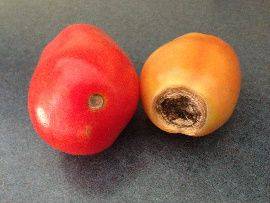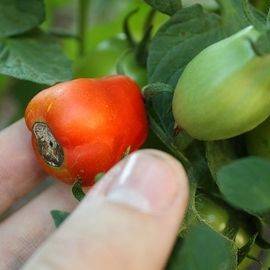 This summer my tomato plants are suffering from so-called blossom-end rot. The name of this physiological disorder is a misnomer, however.
This summer my tomato plants are suffering from so-called blossom-end rot. The name of this physiological disorder is a misnomer, however.
What you need to know about ovary position: it sounds dirty, but is actually a handy thing to understand when you identify plants. As Laura recently explained, in plants, the ovary/ovaries turn into the fruits, grains, nuts, etc. that we eat. Different types of plants have different positions of their ovaries in relation to where the petals are formed. For example, zucchini have inferior ovaries, as seen in my amazing line drawing on the left below. Apples have the same ovary position; the next time you pick up an apple, note the sepals from the flower above the fruit (fully developed ovary). Alternatively tomatoes have superior ovaries, meaning that the petals and sepals are below where the fruit will develop. I included an example of this on the right below.


So blossom-end rot is a misnomer. The position of the blossom, or petals, etc., is different depending on where the ovary is. Since cucumbers and their relatives can get blossom-end rot, the name does not really make sense. I find it irritating, but end-of-ovary-farthest-from-the-stem rot doesn’t really have the same ring to it.
If you happen to find that your plants have blossom-end rot, there is hope for future fruit. Unfortunately, however, the fruit already displaying symptoms is lost. But you can save future fruits by changing watering strategies (use a cone watering system, which waters roots better), using mulch around your potted plants to prevent evaporation, and adding some calcium to your soil. I’ve tried #1 and #3; hopefully I get some healthy tomatoes soon so I can make them into shmoo in fresh pico de gallo!








